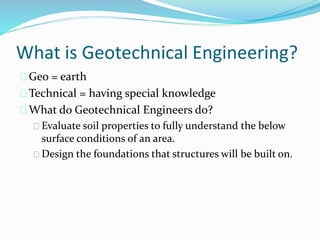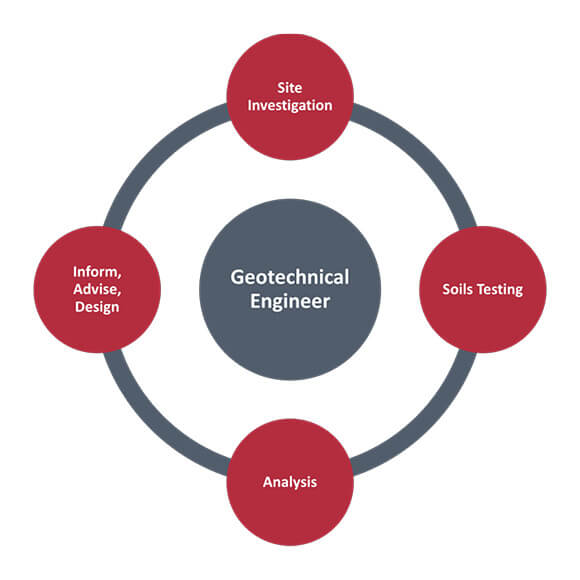What Does Geotheta Do?
What Does Geotheta Do?
Blog Article
Rumored Buzz on Geotheta
Table of ContentsNot known Facts About GeothetaRumored Buzz on Geotheta10 Easy Facts About Geotheta ShownHow Geotheta can Save You Time, Stress, and Money.About Geotheta

They conduct website examinations, gather examples, do lab tests, and assess information to examine the viability of the ground for construction projects - Geotechnical Engineers. Based on their findings, geotechnical designers give referrals for foundation design, slope stability, maintaining structures, and mitigation of geotechnical risks. They team up with various other experts, such as engineers, architectural designers, and building and construction teams, to ensure that geotechnical factors to consider are incorporated into the total project style and application
By examining the actions and buildings of dirt and rock, they can recognize prospective geotechnical dangers such as landslides, soil negotiation, or incline instability. Their knowledge assists protect against failures or accidents that might endanger lives and property. Here are some detailed duties and obligations of a geotechnical designer: Website Examination: Geotechnical engineers conduct website investigations to collect data on subsurface problems.
They analyze the information to recognize the residential or commercial properties and behavior of the dirt and rock, including their toughness, permeability, compaction attributes, and groundwater problems. Geotechnical Analysis and Layout: Geotechnical engineers evaluate the information gathered throughout site examinations to analyze the stability and suitability of the site for construction tasks. They carry out geotechnical estimations and modeling to review factors such as birthing capacity, negotiation, slope security, side planet stress, and groundwater circulation.
The Ultimate Guide To Geotheta
Foundation Design: Geotechnical engineers play a crucial duty in making structures that can safely sustain the desired framework. They evaluate the soil conditions and load demands to establish the suitable structure type, such as shallow structures (e.g., footings), deep structures (e.g (https://forums.hostsearch.com/member.php?265240-geotheta)., heaps), or specialized methods like soil renovation. They take into consideration aspects such as settlement restrictions, birthing ability, and soil-structure communication to establish optimal structure layouts
They evaluate building plans, display site activities, and carry out field evaluations to verify that the design suggestions are followed. If unanticipated geotechnical issues occur, they assess the situation and supply referrals for remediation or adjustments to the style. Danger Analysis and Reduction: Geotechnical engineers assess geotechnical risks and dangers connected with the project website, such as landslides, liquefaction, or dirt erosion.

Partnership and Communication: Geotechnical designers work closely with other experts associated with a job, such as designers, structural engineers, and building and construction groups. Efficient interaction and partnership are important to integrate geotechnical considerations into the general project style and building and construction procedure. Geotechnical engineers provide technical knowledge, response queries, and ensure that geotechnical demands are met.
Geotheta Can Be Fun For Everyone
Below are some kinds of geotechnical designers: Structure Designer: Structure engineers specialize in creating and examining foundations for frameworks. They analyze the dirt conditions, tons requirements, and additional hints site attributes to identify one of the most suitable structure type and style, such as shallow foundations, deep structures, or specialized methods like pile foundations.
They assess the factors affecting incline stability, such as soil homes, groundwater conditions, and incline geometry, and create methods to avoid slope failings and mitigate dangers. Quake Designer: Earthquake engineers specialize in assessing and making structures to stand up to seismic forces. They analyze the seismic threat of a website, assess soil liquefaction capacity, and develop seismic layout criteria to make certain the security and resilience of frameworks during quakes.
They do field screening, gather samples, and analyze the collected data to identify the dirt properties, geologic formations, and groundwater problems at a site. Geotechnical Instrumentation Designer: Geotechnical instrumentation engineers concentrate on monitoring and determining the habits of dirt, rock, and structures. They set up and keep instrumentation systems that check factors such as dirt negotiation, groundwater degrees, slope activities, and structural variations to examine performance and provide early cautions of prospective issues.
The Of Geotheta
They conduct examinations such as triaxial examinations, debt consolidation tests, straight shear examinations, and leaks in the structure examinations to gather data for geotechnical evaluation and layout. Geosynthetics Designer: Geosynthetics engineers focus on the design and application of geosynthetic materials, such as geotextiles, geogrids, and geomembranes. They use these materials to improve dirt stability, strengthen inclines, supply drain options, and control erosion.
They tend to be investigatory individuals, which indicates they're intellectual, introspective, and investigative. They wonder, methodical, logical, logical, and logical. A few of them are likewise social, suggesting they're kind, charitable, participating, client, caring, handy, compassionate, sensible, and friendly. Does this noise like you? Take our cost-free career test to discover if geotechnical designer is among your top career suits.
In the office setting, geotechnical designers use specialized software application tools to carry out computations, develop designs, and analyze data. They prepare reports, evaluation task requirements, connect with clients and staff member, and coordinate task activities. The office setting provides a conducive environment for research, analysis, and collaboration with various other professionals entailed in the project.
3 Simple Techniques For Geotheta
They frequently go to job sites to carry out website examinations, assess geotechnical problems, and gather information for evaluation. These sees involve taking a trip to different areas, in some cases in remote or tough terrains. Geotechnical engineers might carry out dirt tasting, conduct tests, and screen building and construction tasks to guarantee that the geotechnical elements of the project are being executed correctly.
Geotechnical engineers also operate in specialized geotechnical laboratories. In these facilities, they perform experiments, carry out examinations on soil and rock examples, and analyze the engineering homes of the materials. Geotechnical laboratory engineers work thoroughly in these settings, managing testing equipment, running tools, and taping data. They work together with other lab personnel to guarantee accurate and dependable testing results.
Report this page